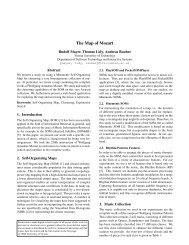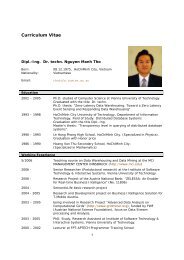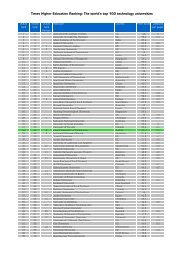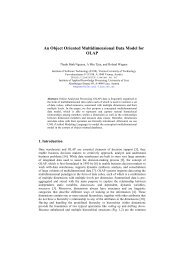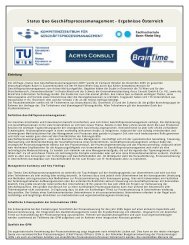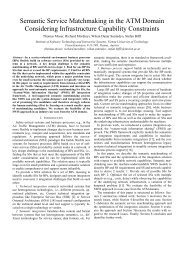Using Psycho-Acoustic Models and Self-Organizing Maps to Create ...
Using Psycho-Acoustic Models and Self-Organizing Maps to Create ...
Using Psycho-Acoustic Models and Self-Organizing Maps to Create ...
You also want an ePaper? Increase the reach of your titles
YUMPU automatically turns print PDFs into web optimized ePapers that Google loves.
W<br />
<strong>Using</strong> <strong>Psycho</strong>-<strong>Acoustic</strong> <strong>Models</strong> <strong>and</strong> ¢¡¤£¦¥ <strong>to</strong> create a Hierarchical Structuring of Music<br />
<strong>Using</strong> <strong>Psycho</strong>-<strong>Acoustic</strong> <strong>Models</strong> <strong>and</strong> <strong>Self</strong>-<strong>Organizing</strong> <strong>Maps</strong><br />
<strong>to</strong> <strong>Create</strong> a Hierarchical Structuring of<br />
Music by Sound Similarity<br />
§<br />
Andreas Rauber<br />
Dept. of Software Technology<br />
Vienna Univ. of Technology<br />
A-1040 Vienna, Austria<br />
<strong>and</strong>i@ifs.tuwien.ac.at<br />
ABSTRACT<br />
With the advent of large musical archives the need <strong>to</strong> provide an<br />
organization of these archives becomes eminent. While artist-based<br />
organizations or title indexes may help in locating a specific piece<br />
of music, a more intuitive, genre-based organization is required <strong>to</strong><br />
allow users <strong>to</strong> browse an archive <strong>and</strong> explore its contents. Yet,<br />
currently these organizations following musical styles have <strong>to</strong> be<br />
designed manually.<br />
In this paper we propose an approach <strong>to</strong> au<strong>to</strong>matically create a<br />
hierarchical organization of music archives following their perceived<br />
sound similarity. More specifically, characteristics of frequency<br />
spectra are extracted <strong>and</strong> transformed according <strong>to</strong> psycho-acoustic<br />
models. Subsequently, the Growing Hierarchical <strong>Self</strong>-<strong>Organizing</strong><br />
Map, a popular unsupervised neural network, is used <strong>to</strong> create a<br />
hierarchical organization, offering both an interface for interactive<br />
exploration as well as retrieval of music according <strong>to</strong> perceived<br />
sound similarity.<br />
1. INTRODUCTION<br />
With the availability of high-quality audio file formats at sufficient<br />
compression rates, we find music increasingly being distributed<br />
electronically via large music archives, offering music from the<br />
public domain, selling titles, or streaming them on a pay-per-play<br />
basis, or simply in the form of on-line retailers for conventional<br />
distribution channels. A core requirement for these archives is the<br />
possibility for the user <strong>to</strong> locate a title he or she is looking for, or <strong>to</strong><br />
find out which types of music are available in general.<br />
Thus, those archives commonly offer several ways <strong>to</strong> find a desired<br />
piece of music. A straightforward approach is <strong>to</strong> use text based<br />
queries <strong>to</strong> search for the artist, the title or some phrase in the lyrics.<br />
While this approach allows the localization of a desired piece of music,<br />
it requires the user <strong>to</strong> know <strong>and</strong> actively input information about<br />
the title he or she is looking for. An alternative approach, allowing<br />
users <strong>to</strong> explore the music archive, searching for musical styles,<br />
rather than for a specific title or group, is thus usually provided in the<br />
form of genre hierarchies such as ¨©© , , . Hence, a<br />
cus<strong>to</strong>mer looking for an opera recording might look in<strong>to</strong> the ¨©<br />
section, <strong>and</strong> will there find - depending on the further organization of<br />
the music archive - a variety of interpretations, being similar in style,<br />
<strong>and</strong> thus possibly suiting his or her likings. However, such organizations<br />
rely on manual categorizations <strong>and</strong> usually consist of several<br />
hundred categories which involve high maintenance costs, in particular<br />
for dynamic music collections, where multiple contribu<strong>to</strong>rs<br />
"!$#%'&(%*)+ ,¢-.&$#/0-.!$,'1&$234-5)+ 6 3.%7)34!$89%7)&$#"-.!$,'!:2;=.?A@B
‘<br />
‘<br />
—<br />
<strong>Using</strong> <strong>Psycho</strong>-<strong>Acoustic</strong> <strong>Models</strong> <strong>and</strong> ¢¡¤£¦¥ <strong>to</strong> create a Hierarchical Structuring of Music<br />
available as MIDI. A more readily available format is the raw audio<br />
signal <strong>to</strong> which all other audio formats can be decoded. One of the<br />
first audio retrieval approaches dealing with music was presented<br />
in [35], where attributes such as the pitch, loudness, brightness <strong>and</strong><br />
b<strong>and</strong>width of speech <strong>and</strong> individual musical notes were analyzed.<br />
Several overviews of systems based on the raw audio data have been<br />
presented, e.g. [9, 18]. However, most of these systems do not treat<br />
content-based music retrieval in detail, but mainly focus on speech<br />
or partly-speech audio data, with one of the few exceptions being<br />
presented in [17], using hummed queries against an MP3 archive<br />
for melody-based retrieval.<br />
Furthermore, only few approaches in the area of content-based music<br />
analysis have utilized the framework of psychoacoustics. <strong>Psycho</strong>acoustics<br />
deals with the relationship of physical sounds <strong>and</strong> the human<br />
brain’s interpretation of them, cf. [37]. One of the first exceptions<br />
was [8], where psychoacoustic models are used <strong>to</strong> describe the similarity<br />
of instrumental sounds. The approach was demonstrated using<br />
a collection of about 100 instruments, which were organized using<br />
a `._$©r$ea \ oRg¢t$Agojbv:w in a similar way as presented in this paper.<br />
For each instrument a 300 milliseconds sound was analyzed <strong>and</strong><br />
steady state sounds with a duration of 6 milliseconds were extracted.<br />
These steady state sounds can be regarded as the smallest possible<br />
building blocks of music. A model of the human perceptual behavior<br />
of music using psychoacoustic findings was presented in [30]<br />
<strong>to</strong>gether with methods <strong>to</strong> compute the similarity of two pieces of<br />
music. A more practical approach <strong>to</strong> the <strong>to</strong>pic was presented in [33]<br />
where music given as raw audio is classified in<strong>to</strong> genres based on<br />
musical surface <strong>and</strong> rhythm features. The features are similar <strong>to</strong><br />
the rhythm patterns we extract, the main difference being that we<br />
analyze them separately in 20 frequency b<strong>and</strong>s.<br />
Our work is based on first experiments reported in [26]. In particular<br />
we have redesigned the feature extraction process using psychoacoustic<br />
models. Additionally, by using a hierarchical extension of<br />
the neural network for data clustering we are able <strong>to</strong> detect the<br />
hierarchical structure within our archive.<br />
3. FEATURE EXTRACTION<br />
The architecture of the `Fa0bc_d system may be divided in<strong>to</strong> 3<br />
stages as depicted in Figure 1. Digitized music in good sound quality<br />
(44kHz, stereo) with a duration of one minute is represented<br />
by approximately 10MB of data in its raw format describing the<br />
physical properties of the acoustical waves we hear. In a preprocessing<br />
stage, the audio signal is transformed, down-sampled <strong>and</strong><br />
split in<strong>to</strong> individual segments (steps P1 <strong>to</strong> P3). We then extract features<br />
which are robust <strong>to</strong>wards non-perceptive variations <strong>and</strong> on the<br />
other h<strong>and</strong> resemble characteristics which are critical <strong>to</strong> our hearing<br />
sensation, i.e. rhythm patterns in various frequency b<strong>and</strong>s. The<br />
feature extraction stage can be divided in<strong>to</strong> two subsections, consisting<br />
of the extraction of the specific loudness sensation expressed in<br />
`'g._ (steps S1 <strong>to</strong> S6), as well as the conversion in<strong>to</strong> time-invariant<br />
frequency-specific rhythm patterns (step R1 <strong>to</strong> R3). Finally, the data<br />
may be optionally converted, before being organized in<strong>to</strong> clusters in<br />
steps A1 <strong>to</strong> A3 using the mNp{`Fa0b . The feature extraction steps are<br />
further detailed in the following subsections, with the clustering procedure<br />
being described in Section 4, with the visualization metaphor<br />
being only <strong>to</strong>uched upon briefly due <strong>to</strong> space considerations.<br />
3.1 Preprocessing<br />
€ ) The pieces of music may be given in any audio file format,<br />
(<br />
such as e.g. MP3 files. We first decode these <strong>to</strong> the ‚ [ © $_ƒ¨0iR_<br />
raw<br />
[ ©~g (PCM) audio format.<br />
bvi<br />
) The raw audio format of music in good quality requires huge<br />
(…„<br />
amounts of s<strong>to</strong>rage. As humans can easily identify the genre of a<br />
piece of music even if its sound quality is rather poor we can safely<br />
reduce the quality of the audio signal. Thus, stereo sound quality<br />
is first reduced <strong>to</strong> mono <strong>and</strong> the signal is then down-sampled from<br />
F<br />
e<br />
a<br />
t<br />
u<br />
r<br />
e<br />
E<br />
x<br />
t<br />
r<br />
a<br />
c<br />
t<br />
i<br />
o<br />
n<br />
Preprocessing<br />
Specific<br />
Loudness<br />
Sensation<br />
(Sone)<br />
Rhythm<br />
Patterns<br />
per<br />
Frequency<br />
B<strong>and</strong><br />
Analysis<br />
P1: Audio -> PCM<br />
P2: Stereo -> Mono, 44kHz->11kHz<br />
P3: music -> segments<br />
S1: Power Spectrum<br />
S2: Critical B<strong>and</strong>s<br />
S3: Spectral Masking<br />
S4:Decibel - dB-SPL<br />
S5: Phon: Equal Loudness<br />
S6: Sone: Specific Loudness Sens.<br />
R1: Modulation Amplitude<br />
R2: Fluctuation Strength<br />
R3: Modified Fluctuation Strength<br />
A1: Median vec<strong>to</strong>r (opt.)<br />
A2: Dimension Reduction (opt.)<br />
A3: GHSOM Clustering<br />
Visualization: Isl<strong>and</strong>s of Music <strong>and</strong> Weather Charts<br />
€¢fŽ45‘<br />
Œs’”“ •=Œ"‹•F‡yŒQ–<br />
q—<br />
‹Œ ‹˜4Œ<br />
‡š5‰F› „"œ‘ ‰'Œ<br />
†ˆ‡y‰=ŠF‹Œ<br />
Œ<br />
¢‘<br />
Š5‹9ŒqŒ"Ÿ ‹ ‡y˜.š0› R¡Š<br />
‘<br />
Œ"‹ š ¡<br />
F ‡ ¢ šF£¤•5‡ Š ¡A‡y¥ s‘<br />
ž<br />
‡y˜.š<br />
44kHz <strong>to</strong> 11kHz, leaving a dis<strong>to</strong>rted, but still easily recognizable<br />
sound signal comparable <strong>to</strong> phone line quality.<br />
) We subsequently segment each piece in<strong>to</strong> 6-second sequences.<br />
(…¦<br />
The duration of 6 (§R¨L© seconds samples) was chosen heuristically<br />
because it is long enough for humans <strong>to</strong> get an impression of the<br />
style of a piece of music while being short enough <strong>to</strong> optimize<br />
the computations. However, analyses with various settings for the<br />
segmentation have shown no significant differences with respect <strong>to</strong><br />
segment length. After removing the first <strong>and</strong> the last 2 segments<br />
of each piece of music <strong>to</strong> eliminate lead-in <strong>and</strong> fade-out effects,<br />
we retain only every third of the remaining segments for further<br />
analysis. Again, the information lost by this type of reduction has<br />
shown insignificant in various experimental settings.<br />
We thus end up with several segments of 6 seconds of music every<br />
18 seconds at 11kHz for each piece of music. The preprocessing<br />
results in a data reduction by a fac<strong>to</strong>r of over 24 without losing<br />
relevant information, i.e. a human listener is still able <strong>to</strong> identify the<br />
genre or style of a piece of music given the few 6-second sequences<br />
in lower quality.<br />
3.2 Specific Loudness Sensation - Sone<br />
Loudness belongs <strong>to</strong> the category of intensity sensations. The loudness<br />
of a sound is measured by comparing it <strong>to</strong> a reference sound.<br />
The 1kHz <strong>to</strong>ne is a very popular reference <strong>to</strong>ne in psychoacoustics,
˜<br />
‘<br />
Œ<br />
Œ<br />
‘<br />
¥<br />
<strong>Using</strong> <strong>Psycho</strong>-<strong>Acoustic</strong> <strong>Models</strong> <strong>and</strong> ¢¡¤£¦¥ <strong>to</strong> create a Hierarchical Structuring of Music<br />
<strong>and</strong> the loudness of the 1kHz <strong>to</strong>ne at 40dB is defined <strong>to</strong> be ªZ`'g._ .<br />
A sound perceived <strong>to</strong> be twice as loud is defined <strong>to</strong> be 2 `=g=_ <strong>and</strong><br />
so on. In the first stage of the feature extraction process, this specific<br />
loudness sensation (Sone) per critical-b<strong>and</strong> (Bark) in short time<br />
intervals is calculated in 6 steps starting with the PCM data.<br />
) First the power spectrum of the audio signal is calculated. To<br />
(Ž€<br />
do this, the raw audio data is first decomposed in<strong>to</strong> its frequencies<br />
using X4~NX5 [Q\ *_ \u«s\ gsSr \¬ ~g®X X «'¯<br />
a . We use a window<br />
size of 256 samples, which corresponds <strong>to</strong> about 23ms at 11kHz,<br />
<strong>and</strong> a Hanning window with 50% overlap. We thus obtain a Fourier<br />
transform of 11 / 2 kHz, i.e. 5.5 kHz signals.<br />
) The inner ear separates the frequencies <strong>and</strong> concentrates them<br />
(ŽF„<br />
at certain locations along the basilar membrane. The inner ear<br />
can thus be regarded as a complex system of a series of b<strong>and</strong>pass<br />
filters with an asymmetrical shape of frequency response. The<br />
center frequencies of these b<strong>and</strong>-pass filters are closely related <strong>to</strong> the<br />
critical-b<strong>and</strong> rates, where frequencies are bundled in<strong>to</strong> 24 criticalb<strong>and</strong>s<br />
according <strong>to</strong> the d| \ scale [37]. Where these b<strong>and</strong>s should<br />
be centered, or how wide they should be, has been analyzed through<br />
several psychoacoustic experiments. Since our signal is limited <strong>to</strong><br />
5.5 kHz we use only the first 20 critical b<strong>and</strong>s, summing up the<br />
values of the power spectrum within the upper <strong>and</strong> lower frequency<br />
limits of each b<strong>and</strong>, obtaining a power spectrum of the 20 critical<br />
b<strong>and</strong>s for the segments.<br />
) Spectral Masking is the occlusion of a quiet sound by a louder<br />
(ŽF¦<br />
sound when both sounds are present simultaneously <strong>and</strong> have similar<br />
frequencies. Spectral masking effects are calculated based on [31],<br />
with a spreading function defining the influence of ° the -th critical<br />
b<strong>and</strong> on the -th being used <strong>to</strong> obtain a spreading matrix. <strong>Using</strong><br />
this matrix the power spectrum is spread across the critical b<strong>and</strong>s<br />
obtained in the previous step, where the masking influence of a<br />
critical b<strong>and</strong> is higher on b<strong>and</strong>s above it than on those below it.<br />
) The intensity unit of physical audio signals is sound pressure<br />
(Ž4±<br />
<strong>and</strong> is measured ‚:© in (Pa). The values of the PCM data<br />
correspond <strong>to</strong> the sound pressure. Before `=g._ calculating values<br />
it is necessary <strong>to</strong> transform the data in<strong>to</strong> decibel. The decibel value<br />
of a sound is calculated as the ratio between its pressure <strong>and</strong> the<br />
pressure of the hearing threshold, also known as dB-SPL, where<br />
SPL is the abbreviation for sound pressure level.<br />
) The relationship between the sound pressure level in decibel<br />
(ŽF²<br />
<strong>and</strong> our hearing sensation measured `'g._ in is not linear. The<br />
perceived loudness depends on the frequency of the <strong>to</strong>ne. From the<br />
dB-SPL values we thus calculate the equal loudness levels with their<br />
unit Phon. The ‚Nhsg levels are defined through the loudness in dB-<br />
SPL of a <strong>to</strong>ne with 1kHz frequency. A level of 40 ‚0hsg resembles<br />
the loudness level of a 40dB-SPL <strong>to</strong>ne at 1kHz. A pure <strong>to</strong>ne at<br />
any frequency with 40 ‚0hsg is perceived as loud as a pure <strong>to</strong>ne<br />
with 40dB at 1kHz. We are most sensitive <strong>to</strong> frequencies around<br />
2kHz <strong>to</strong> 5kHz. The hearing threshold rapidly rises around the lower<br />
<strong>and</strong> upper frequency limits, which are respectively about 20Hz <strong>and</strong><br />
16kHz. Although the values for the equal loudness con<strong>to</strong>ur matrix<br />
are obtained from experiments with pure <strong>to</strong>nes, they may be applied<br />
<strong>to</strong> calculate the specific loudness of the critical b<strong>and</strong> rate spectrum,<br />
resulting in loudness level representations for the frequency ranges.<br />
) Finally, as the perceived loudness sensation differs for different<br />
(ŽF³<br />
loudness levels, the specific loudness sensation `=g=_ in is calculated<br />
based on [3]. The loudness of the 1kHz <strong>to</strong>ne at 40dB-SPL is defined<br />
<strong>to</strong> be 1 Sone. A <strong>to</strong>ne perceived twice as loud is defined <strong>to</strong> be `=g=_ 2<br />
<strong>and</strong> so on. For values up <strong>to</strong> ‚0hsg 40 the sensation rises slowly,<br />
increasing at a faster rate afterwards.<br />
Figure 2 illustrates the data after each of the feature extraction steps<br />
using the first 6-second sequences extracted from d{__:~yhs´_:g¢µNXZY [Q\<br />
] © A$_ <strong>and</strong> from ^ \ g¢µ·X \ _fģ º¹F_C»h . The sequence of XZY<br />
Amplitude<br />
0.05<br />
0<br />
−0.05<br />
Frequency [kHz]<br />
Critical−b<strong>and</strong> [bark]<br />
Critical−b<strong>and</strong> [bark]<br />
Critical−b<strong>and</strong> [bark]<br />
Critical−b<strong>and</strong> [bark]<br />
4<br />
2<br />
PCM Audio Signal<br />
Power Spectrum [dB]<br />
0<br />
Critical−B<strong>and</strong> Rate Spectrum [dB]<br />
20<br />
15<br />
10<br />
5<br />
Spread Critical−B<strong>and</strong> Rate Spectrum [dB]<br />
20<br />
15<br />
10<br />
5<br />
20<br />
15<br />
10<br />
5<br />
Specific Loudness Level [phon]<br />
Specific Loudness Sensation [sone]<br />
20<br />
15<br />
10<br />
5<br />
†ˆ‡y‰=ŠF‹Œ<br />
¡ ‡S‰.š<br />
Beethoven, Für Elise<br />
0 2 4<br />
Time [s]<br />
60<br />
40<br />
20<br />
60<br />
40<br />
20<br />
60<br />
40<br />
20<br />
60<br />
40<br />
20<br />
5<br />
4<br />
3<br />
2<br />
1<br />
Amplitude<br />
Frequency [kHz]<br />
Critical−b<strong>and</strong> [bark]<br />
Critical−b<strong>and</strong> [bark]<br />
Critical−b<strong>and</strong> [bark]<br />
Critical−b<strong>and</strong> [bark]<br />
1<br />
0<br />
−1<br />
4<br />
2<br />
PCM Audio Signal<br />
Power Spectrum [dB]<br />
0<br />
Critical−B<strong>and</strong> Rate Spectrum [dB]<br />
20<br />
15<br />
10<br />
5<br />
Spread Critical−B<strong>and</strong> Rate Spectrum [dB]<br />
20<br />
15<br />
10<br />
5<br />
20<br />
15<br />
10<br />
5<br />
Specific Loudness Level [phon]<br />
Specific Loudness Sensation [sone]<br />
20<br />
15<br />
10<br />
5<br />
Korn, Freak on a Leash<br />
0 2 4<br />
Time [s]<br />
—OuŽ€Rœ:Ž5³4 ž ‹˜.’ ‘9¼ €'€Q½4¾ ¢¿^ÀÁ ŠF£F‡y˜<br />
„4ZŽ4‘ Œs‡S¦¡y˜.Š5£ š5Œ<br />
z—<br />
Œs‹ZR‹9‡ ‡A ¡<br />
œÃF š5£<br />
—<br />
© A$_ contains the main theme starting shortly before the 2nd second.<br />
]<br />
The specific loudness sensation depicts each piano key played. On<br />
the other X \ _¤gÄj¹F_C»h h<strong>and</strong>, , which is classified p¢_C´} as<br />
, is quite aggressive. Melodic elements do not<br />
bv_:~*©Å"Æ^_C~yhubc_:~*©<br />
play a major role <strong>and</strong> the specific loudness sensation is a rather<br />
complex pattern spread over the whole frequency range, whereas<br />
only the lower critical b<strong>and</strong>s are active XZY [Q\] © A$_ in . Notice further,<br />
that the values of the patterns X \ _C9vģ q¹F_C»h of are up <strong>to</strong> 18<br />
times higher compared <strong>to</strong> those XZY [Q\{] © A$_ of .<br />
3.3 Rhythm Patterns<br />
After the first preprocessing stage a piece of music is represented<br />
by several 6-second sequences. Each of these sequences contains<br />
information on how loud the piece is at a specific point in time in a<br />
specific frequency b<strong>and</strong>. Yet, the current data representation is not<br />
time-invariant. It may thus not be used <strong>to</strong> compare two pieces of<br />
music point-wise, as already a small time-shift of a few milliseconds<br />
will usually result in completely different feature vec<strong>to</strong>rs. In the<br />
second stage of the feature extraction process, we calculate a timeinvariant<br />
representation for each piece of music in 3 further steps,<br />
namely the frequency-wise rhythm pattern. These rhythm patterns<br />
contain information on how strong <strong>and</strong> fast beats are played within<br />
the respective frequency b<strong>and</strong>s.<br />
) The loudness of a critical-b<strong>and</strong> usually rises <strong>and</strong> falls several<br />
(Çj€<br />
times resulting in a more or less periodical pattern, also known as<br />
the rhythm. The loudness values of a critical-b<strong>and</strong> over a certain<br />
time period can be regarded as a signal that has been sampled at<br />
discrete points in time. The periodical patterns of this signal can<br />
then be assumed <strong>to</strong> originate from a mixture of sinuids. These<br />
sinuids modulate the amplitude of the loudness, <strong>and</strong> can be calculated<br />
by a Fourier transform. The modulation frequencies, which<br />
80<br />
60<br />
40<br />
20<br />
80<br />
60<br />
40<br />
80<br />
60<br />
40<br />
80<br />
60<br />
40<br />
25<br />
20<br />
15<br />
10<br />
5<br />
[Q\
Œ<br />
Š<br />
‘<br />
˜<br />
‘<br />
<strong>Using</strong> <strong>Psycho</strong>-<strong>Acoustic</strong> <strong>Models</strong> <strong>and</strong> ¢¡¤£¦¥ <strong>to</strong> create a Hierarchical Structuring of Music<br />
Critical−b<strong>and</strong> [bark]<br />
Amplitude<br />
Critical−b<strong>and</strong> [bark]<br />
Critical−b<strong>and</strong> [bark]<br />
Critical−b<strong>and</strong> [bark]<br />
20<br />
10<br />
1<br />
0.5<br />
20<br />
10<br />
20<br />
10<br />
20<br />
10<br />
Beethoven, Für Elise<br />
Specific Loudness Sensation<br />
3.6Hz +− 1.5Hz<br />
0 2 4<br />
Time [s]<br />
Modulation Amplitude<br />
Fluctuation Strength<br />
Modified Fluctuation Strength<br />
2 4 6 8 10<br />
Modulation Frequency [Hz]<br />
¦4¦Ž4‘<br />
†ˆ‡y‰.Š5‹9Œ<br />
Œ"£BÉ0ŠF ’v˜4£O‡tÂ<br />
5<br />
4<br />
3<br />
2<br />
1<br />
25<br />
20<br />
15<br />
10<br />
5<br />
2<br />
1.5<br />
1<br />
0.5<br />
0.5<br />
0.4<br />
0.3<br />
0.2<br />
0.1<br />
Critical−b<strong>and</strong> [bark]<br />
Amplitude<br />
Critical−b<strong>and</strong> [bark]<br />
Critical−b<strong>and</strong> [bark]<br />
Critical−b<strong>and</strong> [bark]<br />
20<br />
10<br />
1<br />
0.5<br />
20<br />
10<br />
20<br />
10<br />
20<br />
10<br />
Korn, Freak on a Leash<br />
Specific Loudness Sensation<br />
6.9Hz +− 2.7Hz<br />
0 2 4<br />
Time [s]<br />
Modulation Amplitude<br />
Fluctuation Strength<br />
Modified Fluctuation Strength<br />
2 4 6 8 10<br />
Modulation Frequency [Hz]<br />
ž ‹9˜=’È¡y˜.Š5£ š5Œ j Œsš ¢‘<br />
‡y˜.š<br />
—OqǦ€œÇº¦4 ‡y˜=š<br />
‘<br />
‹Œ¢š4‰<br />
‘9¼ ¢‘<br />
can be analyzed using the 6-second sequences <strong>and</strong> time quanta of<br />
12ms, are in the range from 0 <strong>to</strong> 43Hz with an accuracy of 0.17Hz.<br />
Notice that a modulation frequency of 43Hz corresponds <strong>to</strong> almost<br />
2600bpm. Thus, the amplitude modulation of the loudness sensation<br />
per critical-b<strong>and</strong> for each 6-second sequence is calculated using<br />
a FFT of the 6-second sequence of each critical b<strong>and</strong>.<br />
) The amplitude modulation of the loudness has different effects<br />
(Ǻ„<br />
on our sensation depending on the frequency. The sensation of<br />
Ê [ $~ [ ~g®~ \ _:go~yh is most intense at a a modulation frequency<br />
of around 4Hz <strong>and</strong> gradually decreases up <strong>to</strong> 15Hz. At 15Hz the<br />
sensation of \ [ o9hg._: starts <strong>to</strong> increase, reaches its maximum at<br />
about 70Hz, <strong>and</strong> starts <strong>to</strong> decreases at about 150Hz. Above 150Hz<br />
the sensation of hearing ~yh \ __¤_7w" \ ~7_$© }º [ ik©t_|~*g._: increases.<br />
It is the fluctuation strength, i.e. rhythm patterns up <strong>to</strong> 10Hz, which<br />
corresponds <strong>to</strong> 600 beats per minute (bpm), that we are interested<br />
in. For each of the 20 frequency b<strong>and</strong>s we obtain 60 values for<br />
modulation frequencies between 0 <strong>and</strong> 10Hz. This results in 1200<br />
values representing the fluctuation strength.<br />
) To distinguish certain rhythm patterns better <strong>and</strong> <strong>to</strong> reduce<br />
(Ǻ¦<br />
irrelevant information, gradient <strong>and</strong> Gaussian filters are applied.<br />
In particular, we use gradient filters <strong>to</strong> emphasize distinctive beats,<br />
which are characterized through a relatively high fluctuation strength<br />
at a specific modulation frequency compared <strong>to</strong> the values immediately<br />
below <strong>and</strong> above this specific frequency. We further apply a<br />
Gaussian filter <strong>to</strong> increase the similarity between two rhythm pattern<br />
characteristics which differ only slightly in the sense of either being<br />
in similar frequency b<strong>and</strong>s or having similar modulation frequencies<br />
by spreading the according values. We thus obtain modified<br />
fluctuation strength values that can be used as feature vec<strong>to</strong>rs for<br />
subsequent cluster analysis.<br />
The second part of the feature extraction process is summarized in<br />
Figure 3. Looking at the modulation amplitude XZY [Q\º] © A$_ of it<br />
seems as though there is no beat. In the fluctuation strength subplot<br />
the modulation frequencies around 4Hz are emphasized. Yet, there<br />
are no clear vertical lines, as there are no periodic beats. On the other<br />
25<br />
20<br />
15<br />
10<br />
5<br />
50<br />
40<br />
30<br />
20<br />
10<br />
20<br />
15<br />
10<br />
5<br />
8<br />
6<br />
4<br />
2<br />
h<strong>and</strong>, note the strong beat of around 7Hz in all frequency b<strong>and</strong>s of<br />
X \ _C9ƒgqx¹F_C»h . For an in-depth discussion of the characteristics<br />
of the feature extraction process, please refer <strong>to</strong> [23, 24].<br />
4. HIERARCHICAL DATA CLUSTERING<br />
<strong>Using</strong> the rhythm patterns we apply the `=_$©r$ea \ oRgst$AgQo¸bvw<br />
) [13], as well as its extension, the m \ nAgQoqp¤_ \ \ hQ©<br />
(`5aNb<br />
\ oRgst$AgQovbv:w (mNp¤`5aNb ) [6] algorithm <strong>to</strong> organize the<br />
`=_$©r$ea<br />
pieces of music on a 2-dimensional map display in such a way that<br />
similar pieces are grouped close <strong>to</strong>gether. In the following sections<br />
we will briefly review the principles of `Fa0b the <strong>and</strong> mNp{`Fa0b the ,<br />
followed by a description of the last steps of `5aNbc_d the system,<br />
i.e. the cluster analysis steps A1 <strong>to</strong> A3 in Figure 1.<br />
4.1 <strong>Self</strong>-<strong>Organizing</strong> <strong>Maps</strong><br />
The `._$©r$ea \ oRg¢t$AgoËbv:w (`FaNb ), as proposed in [12] <strong>and</strong> described<br />
thoroughly in [13], is one of the most distinguished unsupervised<br />
artificial neural network models. It basically provides<br />
cluster analysis by producing a mapping of high-dimensional input<br />
data on<strong>to</strong> a usually 2-dimensional output space while preserving the<br />
<strong>to</strong>pological relationships between the input data items as faithfully<br />
as possible. In other words, `5aNb the produces a projection of the<br />
data space on<strong>to</strong> a two-dimensional map space in such a way, that<br />
similar data items are located close <strong>to</strong> each other on the map.<br />
More formally, the `FaNb<br />
consists of a set of units Ì , which are arranged<br />
according <strong>to</strong> some <strong>to</strong>pology, where the most common choice<br />
is a two-dimensional grid. Each of the units Ì is assigned a model<br />
vec<strong>to</strong>r ÍqÎ of the same dimension as the input data, ÍqÎ|ϸÐÑ . In<br />
the initial setup of the model prior <strong>to</strong> training, the model vec<strong>to</strong>rs<br />
are frequently initialized with r<strong>and</strong>om values. However, more sophisticated<br />
strategies such as, for example, Principle Component<br />
Analysis, may be applied. During each learning step Ò , an input<br />
pattern ÓOÔAÒÕ is r<strong>and</strong>omly selected from the set of input vec<strong>to</strong>rs <strong>and</strong><br />
presented <strong>to</strong> the map. Next, the unit showing the most similar model<br />
vec<strong>to</strong>r with respect <strong>to</strong> the presented input signal is selected as the<br />
winner Ö , where a common choice for similarity computation is the<br />
Euclidean distance, cf. Expression 1.<br />
θà ÙtÙÓOÔAÒCÕ ÚvÍjÎCÔAÒCÕÙtÙ á Ô»âÕ<br />
ÖÔAÒÕØ×'ÙtÙÓOÔAÒCÕFÚcÍuÛÔAÒCÕÙtÙÜÄ݃Þtß<br />
Adaptation takes place at each learning iteration <strong>and</strong> is performed<br />
as a gradual reduction of the difference between the respective components<br />
of the input vec<strong>to</strong>r <strong>and</strong> the model vec<strong>to</strong>r. The amount of<br />
adaptation is guided by a mono<strong>to</strong>nically decreasing<br />
ã<br />
learning-rate<br />
, ensuring large adaptation steps at the beginning of the training<br />
process, followed by a fine-tuning-phase <strong>to</strong>wards the end.<br />
Apart from the winner, units in a time-varying <strong>and</strong> gradually decreasing<br />
neighborhood around the winner are adapted as well. This<br />
enables a spatial arrangement of the input patterns such that alike<br />
inputs are mapped on<strong>to</strong> regions close <strong>to</strong> each other in the grid of<br />
output units. Thus, the training process of the self-organizing map<br />
results in a <strong>to</strong>pological ordering of the input patterns. According<br />
<strong>to</strong> [27] the self-organizing map can be viewed as a neural network<br />
model performing a spatially smooth version of ä -means clustering.<br />
The neighborhood of units around the winner may be described<br />
implicitly by means of a neighborhood-kernel å¢ÛLÎ taking in<strong>to</strong> account<br />
the distance – in terms of the output space – between unit Ì<br />
under consideration <strong>and</strong> Ö unit , the winner of the current learning<br />
iteration. A Gaussian may be used <strong>to</strong> define the neighborhoodkernel,<br />
ensuring stronger adaption of units close <strong>to</strong> the winner. It is<br />
common practice that in the beginning of the learning process the<br />
neighborhood-kernel is selected large enough <strong>to</strong> cover a wide area<br />
of the output space. The spatial width of the neighborhood-kernel<br />
is reduced gradually during the learning process such that <strong>to</strong>wards<br />
the end of the learning process just the winner itself is adapted.
“<br />
‘<br />
‘<br />
‡<br />
‘<br />
<strong>Using</strong> <strong>Psycho</strong>-<strong>Acoustic</strong> <strong>Models</strong> <strong>and</strong> ¢¡¤£¦¥ <strong>to</strong> create a Hierarchical Structuring of Music<br />
layer 0<br />
æ n<br />
layer 1<br />
x(t)<br />
m(t) m(t+1) c<br />
c<br />
c<br />
layer 2<br />
Input Space<br />
Output Space<br />
layer 3<br />
‡S˜.š<br />
˜=‹ £<br />
‹ ‡šF‡š4‰ ’v˜4£FŒ"¡Ø•=Œ"<br />
†J‡S‰.ŠF‹Œ<br />
Œ"<br />
ŠF‹Œ<br />
²4jñ¤ò¦ó·ôˆõö ‹9 ¼<br />
'—F‘<br />
†ˆ‡y‰.ŠF‹Œ<br />
±F^Ž<br />
In combining these principles of self-organizing map training, we<br />
may write the learning rule as given in Expression (2), with ã representing<br />
the time-varying learning-rate, å ÛLÎ representing the timevarying<br />
neighborhood-kernel, Ó representing the currently presented<br />
input pattern, <strong>and</strong> ÍqÎ denoting the model vec<strong>to</strong>r assigned <strong>to</strong> unit Ì .<br />
A simple graphical representation of a self-organizing map’s architecture<br />
<strong>and</strong> its learning process is provided in Figure 4. In this<br />
Í Î ÔAÒ5éÄâ9ÕÜÄÍ Î ÔAÒÕ4é ã ÔAÒÕOêå ÛLÎ ÔAÒCÕ êRëÓOÔAÒÕOÚfÍ Î ÔAÒÕ7ì<br />
figure the output space consists of a square of 36 units, depicted<br />
as circles, forming a grid of íºî¦í units. One input vec<strong>to</strong>r ÓOÔAÒCÕ is<br />
r<strong>and</strong>omly chosen <strong>and</strong> mapped on<strong>to</strong> the grid of output units. The<br />
winner Ö showing the highest activation is determined. Consider the<br />
winner being the unit depicted as the black unit labeled in the figure.<br />
The model vec<strong>to</strong>r of the winner, ÍqÛÔAÒÕ , is now moved <strong>to</strong>wards<br />
the current input vec<strong>to</strong>r. This movement is symbolized in the input<br />
space in Figure 4. As a consequence of the adaptation, unit Ö will<br />
produce an even higher activation with respect <strong>to</strong> the input pattern<br />
Ó at the next learning iteration, Ò.éïâ , because the unit’s model vec<strong>to</strong>r,<br />
ÍqÛ9ÔAÒFéðâÕ , is now nearer <strong>to</strong> the input pattern Ó in terms of the<br />
input space. Apart from the winner, adaptation is performed with<br />
neighboring units, <strong>to</strong>o. Units that are subject <strong>to</strong> adaptation are depicted<br />
as shaded units in the figure. The shading of the various units<br />
corresponds <strong>to</strong> the amount of adaptation, <strong>and</strong> thus, <strong>to</strong> the spatial<br />
width of the neighborhood-kernel. Generally, units in close vicinity<br />
of the winner are adapted more strongly, <strong>and</strong> consequently, they are<br />
depicted with a darker shade in the figure.<br />
Being a decidedly stable <strong>and</strong> flexible model, `5aNb the has been employed<br />
in a wide range of applications, ranging from financial data<br />
analysis, via medical data analysis, <strong>to</strong> time series prediction, industrial<br />
control, <strong>and</strong> many more [5, 13, 32]. It basically offers itself<br />
<strong>to</strong> the organization <strong>and</strong> interactive exploration of high-dimensional<br />
data spaces. One of its most prominent application areas is the organization<br />
of large text archives [15, 19, 29], which, due <strong>to</strong> numerous<br />
computational optimizations <strong>and</strong> shortcuts that are possible in this<br />
NN model, scale up <strong>to</strong> millions of documents [11, 14].<br />
However, due <strong>to</strong> its <strong>to</strong>pological characteristics, the `FaNb<br />
Ô*§Õ<br />
not only<br />
serves as the basis for interactive exploration, but may also be used as<br />
an index structure <strong>to</strong> high-dimensional databases, facilitating scalable<br />
proximity searches. Reports on a combination of `5aNbË <strong>and</strong><br />
R*-trees as an index <strong>to</strong> image databases have been reported, for<br />
example, in [20, 21], whereas an index tree based on the `FaNb<br />
is reported in [36]. Thus, `5aNb the combines <strong>and</strong> offers itself in<br />
a convenient way both for interactive exploration, as well as for<br />
the indexing <strong>and</strong> retrieval, of information represented in the form<br />
of high-dimensional feature spaces, where exact matches are either<br />
impossible due <strong>to</strong> the fuzzy nature of data representation or<br />
the respective type of query, or at least computationally prohibitive,<br />
making them particularly suitable for image or music databases.<br />
4.2 The GHSOM<br />
The key idea of the m \ n0ygQoxp{*_ \ \ hQ©`=_$©r$ea \ oRgst$AgQô bvw [6]<br />
is <strong>to</strong> use a hierarchical structure of multiple layers, where each layer<br />
consists of a number of `5aNbË independent . `Fa0b One is used at<br />
the first layer of the hierarchy, representing the respective data in<br />
more detail. For every unit in this map `FaNb a might be added <strong>to</strong><br />
the next layer of the hierarchy. This principle is repeated with the<br />
third <strong>and</strong> any further layers of mNp{`FaNb the .<br />
Since one of the shortcomings `FaNb of usage is its fixed network<br />
architecture we rather use an incrementally growing version of the<br />
. This relieves us from the burden of predefining the network’s<br />
`5aNb<br />
size which is rather determined during the unsupervised training<br />
process. We start with a layer 0, which consists of only one single<br />
unit. The weight vec<strong>to</strong>r of this unit is initialized as the average of<br />
all input data. The training process basically starts with a small map<br />
of, § îj§ say, units in layer 1, which is self-organized according <strong>to</strong><br />
the `Fa0b<br />
st<strong>and</strong>ard training algorithm.<br />
This training process is repeated for a fixed number ÷ of training<br />
iterations. Ever after ÷ training iterations the unit with the largest<br />
deviation between its weight vec<strong>to</strong>r <strong>and</strong> the input vec<strong>to</strong>rs represented<br />
by this very unit is selected as the error unit. In between the error unit<br />
<strong>and</strong> its most dissimilar neighbor in terms of the input space either a<br />
new row or a new column of units is inserted. The weight vec<strong>to</strong>rs<br />
of these new units are initialized as the average of their neighbors.<br />
An obvious criterion <strong>to</strong> guide the training process is ø [ g¢~9e<br />
the<br />
\:\ \¢ù Î , calculated as the sum of the distances between the<br />
~gï_<br />
weight vec<strong>to</strong>r of a Ì unit <strong>and</strong> the input vec<strong>to</strong>rs mapped on<strong>to</strong> this unit.<br />
It is used <strong>to</strong> evaluate the mapping quality of `5aNb a based on<br />
¬<br />
the<br />
[ gs~t~g¤_ \:\ \ (b®û ]<br />
) of all units in the map. A map<br />
_Cgúø<br />
grows until b¤û ]<br />
its falls below a certain ü ¨<br />
fraction of the Î of<br />
the unit ù in the preceding layer of the hierarchy. Thus, the map now<br />
Ì<br />
represents the data of the higher layer Ì unit in more detail.<br />
As outlined above the initial architecture of the mNp{`Fa0b<br />
consists<br />
of `FaNb one . This architecture is exp<strong>and</strong>ed by another layer in case<br />
of dissimilar input data being mapped on a particular unit. These<br />
units are identified by a rather high quantization error Î which is<br />
above a threshold ù . This threshold basically indicates the desired<br />
ü9ý<br />
granularity level of data representation as a fraction of the initial<br />
quantization error at layer 0. In such a case, a new map will be<br />
added <strong>to</strong> the hierarchy <strong>and</strong> the input data mapped on the respective<br />
higher layer unit are self-organized in this new map, which again<br />
grows until b®û ]<br />
its is reduced <strong>to</strong> a ü ¨<br />
fraction of the respective<br />
higher layer unit’s quantization error Î . Note that this does not<br />
necessarily lead <strong>to</strong> a balanced hierarchy. The depth of the hierarchy<br />
will rather reflect the diversity in input data distribution which should<br />
be expected in real-world data collections. Depending on the desired<br />
ù ü ¨<br />
fraction b®û ]<br />
of reduction we may end up with either a very deep<br />
hierarchy with small maps, a flat structure with large maps, or – in<br />
the extreme case – only one large map. The growth of the hierarchy<br />
is terminated when no further units are available for expansion.<br />
Àèç
’<br />
K<br />
<strong>Using</strong> <strong>Psycho</strong>-<strong>Acoustic</strong> <strong>Models</strong> <strong>and</strong> ¢¡¤£¦¥ <strong>to</strong> create a Hierarchical Structuring of Music<br />
1<br />
4<br />
7<br />
0.5<br />
0<br />
0.5<br />
0<br />
0.7<br />
2<br />
5<br />
8<br />
0.9<br />
0<br />
1.8<br />
0<br />
1.8<br />
3<br />
6<br />
9<br />
1.1<br />
0<br />
0.9<br />
0<br />
0.9<br />
music. We have evaluated several alternatives using Gaussian mixture<br />
models, fuzzy c-means, <strong>and</strong> k-means pursuing the assumption<br />
that a piece of music contains significantly different rhythm patterns.<br />
However, the median, despite being by far the simplest technique,<br />
yielded comparable results <strong>to</strong> the more complex methods. Other<br />
simple alternatives such as the the mean proved <strong>to</strong> be <strong>to</strong>o vulnerable<br />
with respect <strong>to</strong> outliers.<br />
1<br />
4<br />
7<br />
10<br />
0<br />
ÔþRÕØÿ¡ ¢<br />
9.1<br />
0.3<br />
4.4<br />
0.3<br />
4.8<br />
0.3<br />
9.1<br />
0.5<br />
Ô'Õ<br />
Median<br />
0<br />
0.7<br />
0<br />
£¥¤§¦©¨<br />
ߧ § Þ<br />
¥<br />
2<br />
5<br />
8<br />
11<br />
¦ ß þ<br />
4.6<br />
0.3<br />
4.5<br />
0.3<br />
4.2<br />
0.3<br />
4.4<br />
0.2<br />
¦<br />
ߦþ þ<br />
¥ ¤<br />
3<br />
6<br />
9<br />
Median<br />
0<br />
6.9<br />
0.3<br />
9<br />
0.3<br />
4.7<br />
0.3<br />
4.2<br />
³4 ç ¼<br />
Œ ‹<br />
¼=5‘9¼ —F¢‘‘<br />
Œs‹š ˜ ž "!©!$#&%('*)§!+-,/.10<br />
†ˆ‡y‰.Š5‹9Œ<br />
! š5£
“<br />
À<br />
‘<br />
<strong>Using</strong> <strong>Psycho</strong>-<strong>Acoustic</strong> <strong>Models</strong> <strong>and</strong> ¢¡¤£¦¥ <strong>to</strong> create a Hierarchical Structuring of Music<br />
bfmc−uprocking<br />
themangotree<br />
bfmc−instereo<br />
bfmc−rocking<br />
bfmc−skylimit<br />
bongobong<br />
cocojambo<br />
limp−n2gether<br />
macarena<br />
rockdj<br />
conga<br />
mindfiels<br />
lovsisintheair<br />
eifel65−blue<br />
fromnewyork<strong>to</strong>la<br />
gowest<br />
manicmonday<br />
radio<br />
supertrouper<br />
sl−summertime<br />
rhcp−californication<br />
rhcp−world<br />
sl−whatigot<br />
bfmc−freestyler<br />
sexbomb<br />
<strong>to</strong>rn<br />
ga−doedel<br />
ga−iwantit<br />
ga−japan<br />
nma−bigblue<br />
limp−nobody<br />
pr−broken<br />
ga−nospeech<br />
limp−pollution<br />
korn−freak<br />
pr−deadcell<br />
pr−revenge<br />
dancingqueen<br />
firsttime<br />
foreveryoung<br />
frozen<br />
californiadream<br />
risingsun<br />
unbreakmyheart<br />
missathing<br />
friend<br />
yesterday−b<br />
eternalflame<br />
feeling<br />
drummerboy<br />
father<strong>and</strong>son<br />
ironic<br />
future<br />
lovemetender<br />
therose<br />
beethoven<br />
fuguedminor<br />
vm−bach<br />
vm−brahms<br />
bigworld<br />
addict<br />
ga−lie<br />
angels<br />
newyork<br />
sml−adia<br />
americanpie<br />
lovedwoman<br />
revolution<br />
memory<br />
rainbow<br />
threetimesalady<br />
br<strong>and</strong>en<br />
air<br />
avemaria<br />
elise<br />
kidscene<br />
mond<br />
†ˆ‡y‰.ŠF‹Œkj<br />
˜ ž ’vŠ ‡yq˜=¡y¡yŒ"<br />
mlu¾¦Ž<br />
‡y˜.š<br />
the same general trends of organization, thus alleviating the common<br />
problem of cluster separation in hierarchical organizations.<br />
Some interesting insights in<strong>to</strong> the music collection which the m0pxe<br />
map, organizing the collection in<strong>to</strong> 9 major styles of music. The<br />
bot<strong>to</strong>m right represents mainly classical music, while the upper left<br />
mainly represents a mixture of Hip Hop, Electro, <strong>and</strong> House by<br />
d| ¬ r [ g"zb¤¨ Ckr ¬ ¯<br />
. The upper-right, center-right, <strong>and</strong> uppercenter<br />
represent mainly disco music such ˆuÆ¢ as ˆRkk$_ by<br />
¬ x \ iL° ¯<br />
, dJ© [ _ by ] n|_$©poPqC_: n|_$©roPqe7k© [ _ ¯<br />
, or X \ _:g<br />
Lº©A©<br />
bfRiRgsg=¦ r \ 9_:g ¯<br />
by . Please note, that the organization does not<br />
follow clean “conceptual” genre styles, splitting by definition, e.g.<br />
wspx:w <strong>and</strong> p… [ $_ , but rather reflects the overall sound similarity.<br />
p{<br />
Seven of these 9 first-level categories are further refined on the second<br />
level. For example, the bot<strong>to</strong>m right unit representing classical<br />
music is divided in<strong>to</strong> 4 further sub-categories. Of these 4 categories<br />
the lower-right represents slow <strong>and</strong> peaceful music, mainly<br />
piano pieces such XZY as<br />
© A$_ËC_$© A$_ ¯<br />
<strong>and</strong> bvg'i:h¢_:Ags$g=~7_<br />
[Q\Z]<br />
¬ g=i ¯<br />
by d{__:~yhs´_:g , or X \ _ ¬ i_º¹ Y g'i_ \q[ g=i¦bc_:g¢:h¢_:g by<br />
<br />
[Q¬ gsg i$_:g=_ ¯<br />
. The upper-right represents, for example,<br />
`'h<br />
pieces sg=_::Ëbf_ by (vm), which, in this case, are more dynamic<br />
interpretations of classical pieces played on the violin. In the<br />
upper-left orchestral music is located such as the as the end credits<br />
of the dJR…~*¢~yhs_X [ ~ [Q\ _<br />
KtKtK<br />
r [ ~ [Q\ _ ¯<br />
film <strong>and</strong> the slow love<br />
«<br />
song<br />
by d{_:~~7_JbËis©t_ \ 7~yh¢_ \ $_ ¯<br />
, exhibiting a more intensive<br />
h¢_ˆ$_<br />
sound sensation, whereas the lower right corner unit represents the<br />
\ g=iR_:g=k [Q\ ov¨0g'_ \ ~ by d|Rhf»k \ g'i_:g ¯<br />
.<br />
d<br />
Generally speaking, we find the softer, more peaceful songs on this<br />
second level map located in the lower half of the map, whereas the<br />
more dynamic, intensive songs are located in the upper half. This<br />
corresponds <strong>to</strong> the general organization of the map in the first layer,<br />
where the unit representing Classic music is located in the lower right<br />
corner, having more aggressive music as its upper <strong>and</strong> left neighbors.<br />
This allows us, even on lower-level maps, <strong>to</strong> move across map<br />
boundaries <strong>to</strong> find similar music on the neighboring map following<br />
reveals are, for example, that the song X \ __:~}©t_ \<br />
by dJ ¬ e<br />
`5aNb<br />
[ gQjb®¨ (center-left) is quite different then the other songs by<br />
r<br />
the same X \ __:~}©t_ \<br />
group. was the groups biggest hit so far <strong>and</strong>,<br />
unlike their other songs, has been appreciate by a broader audience.<br />
Generally, the pieces of one group have similar sound characteristics<br />
<strong>and</strong> thus are located within the same categories. This applies, for<br />
example, <strong>to</strong> the songs m [ g'vu·ws_:¤oR ¯<br />
of ‚:w"…RhjSw \7¯<br />
<strong>and</strong> ,<br />
which are located in the center of the 9 first-level categories <strong>to</strong>gether<br />
with other aggressive rock songs. However, another exception is<br />
u¹O*_ by m [ g' uØws_:uoRe*© *_ ¯<br />
, located in the lowerleft.<br />
Listening <strong>to</strong> this piece reveals, that it is much slower than the<br />
¹OA´Ago¦Aģ<br />
other pieces of the group, <strong>and</strong> that this song matches very well <strong>to</strong>,<br />
for û iRi$~ example, xw ¨Fhs:_ by .<br />
5.2 A GHSOM of 359 pieces of music<br />
In this section we present results from using the `5aNbc_d system<br />
<strong>to</strong> structure a larger collection of 359 pieces of music. Due <strong>to</strong> space<br />
constraints we cannot display or discuss the full hierarchy in detail.<br />
We will thus pick a few examples <strong>to</strong> show the characteristics of the<br />
resulting hierarchy, inviting the reader <strong>to</strong> explore <strong>and</strong> evaluate the<br />
complete hierarchy via the project homepage.<br />
The mNp{`Fa0b<br />
resulting has grown <strong>to</strong> a size §ºîzy of units on the<br />
<strong>to</strong>p layer map. All 8 <strong>to</strong>p-layer units were exp<strong>and</strong>ed on<strong>to</strong> a second<br />
layer in the hierarchy, from which 25 units out of 64 units <strong>to</strong>tal<br />
on this layer were further exp<strong>and</strong>ed in<strong>to</strong> a third layer. None of<br />
the branches required expansion in<strong>to</strong> a fourth layer at the required<br />
level-of-detail setting. An integrated view of the two <strong>to</strong>p-layers of<br />
the map is depicted in Figure 8. We will now take a closer look at
“<br />
À<br />
‘<br />
<strong>Using</strong> <strong>Psycho</strong>-<strong>Acoustic</strong> <strong>Models</strong> <strong>and</strong> ¢¡¤£¦¥ <strong>to</strong> create a Hierarchical Structuring of Music<br />
†J‡S‰.ŠF‹Œ1{<br />
‡y˜.š}|<br />
<br />
˜ ž<br />
ŒË¡ ‹‰'Œ"‹u’vŠ ‡Aj˜=¡y¡yŒ"<br />
‡yŒ"Œ<br />
mlu¾ËŽ<br />
¦¢²(~c—<br />
some branches of this map, <strong>and</strong> compare them <strong>to</strong> the respective areas<br />
in the mNp{`FaNb of the smaller data collection depicted in Figure 7<br />
Generally, we find pieces of soft classical music in the upper right<br />
corner, with the music becoming gradually more dynamic <strong>and</strong> aggressive<br />
as we move <strong>to</strong>wards the bot<strong>to</strong>m left corner of the map.<br />
Due <strong>to</strong> the characteristics of the training process of the mNp{`FaNb<br />
we can find the same general tendency at the respective lower-layer<br />
maps. The overall orientation of the map hierarchy is rotated when<br />
compared <strong>to</strong> the smaller mNp{`FaNb , where the classical titles were<br />
located in the bot<strong>to</strong>m right corner, with the more aggressive titles<br />
placed on the upper left area of the map. This rotation is due <strong>to</strong><br />
the unsupervised nature of mNp¤`5aNb the training process. It can,<br />
however, be avoided by using specific initialization techniques if a<br />
specific orientation of the map were required.<br />
The unit in the upper right corner of the <strong>to</strong>p-layer map, representing<br />
the softest classical pieces of music, is exp<strong>and</strong>ed on<strong>to</strong> a FZîj§ map<br />
in the second layer (exp<strong>and</strong>ed <strong>to</strong> the upper right in Figure 8). Here<br />
we again find the softest, most peaceful pieces in the upper right<br />
corner, namely part of the sound-track of the movie [Q\ {‚ \ ,<br />
next <strong>to</strong> ¹F_C´AgQou‚ \ ~ by ¬ _:¢px \ g._ \<br />
,<br />
« h¢_^bc_ \:\ }u‚ˆ_C:g¢~<br />
by `'h [Q¬ gsg , <strong>and</strong> ¨0g=g by ‚Rh¢_$©k_$© . Below this unit we find<br />
further soft titles, yet somewhat more dynamic. We basically find<br />
all titles that were mapped <strong>to</strong>gether in the bot<strong>to</strong>m right corner unit<br />
of the smaller collection depicted in Figure 7 on<br />
of mNp¤`5aNb the<br />
this unit, uJ \ µ-uJ´_…bv \ µNXZY [Q\x] © A$_:µX \ _ ¬ i_¢¹ Y g'i_ \ [ g=i<br />
i.e.<br />
i:_:g._ ¯<br />
<strong>and</strong> the bvg'i:h¢_:Ag¢:g'~7_ . Furthermore,<br />
bc_:gs:h¢_:ģ<br />
a few additional titles of the larger collection have been mapped<br />
on<strong>to</strong> this unit, the most famous of which probably Æx*_¢©t_:Ag=_<br />
€<br />
are<br />
¬^[ S by bv \ ~ , the X [ g._ \ ©0bv \ h by ¨Fhs:w'yg or the<br />
RhQ~<br />
iRo from the Clarinet Concert by emphMozart.<br />
û<br />
Let us now take a look at the titles that were mapped on<strong>to</strong> the<br />
neighboring units in the previously presented smaller data collection.<br />
The d \ g'i_:g=k [Q\ oA:h¢_x^g9_ \ ~7_ , located on the neighboring unit<br />
<strong>to</strong> the right in the first example, can be found in the lower left corner<br />
of this map, <strong>to</strong>gether with, for u|© :zw \ RhzO \ ~yh [ ~ \ <br />
example,<br />
hs \ i^`¢~ \ [ƒ‚<br />
by . Mapped on<strong>to</strong> the upper neighboring unit in the<br />
mNp{`FaNb smaller we had titles like X0 \ ~=bv´_ ¬ _:gs~OLrN~yh¢_q~yh<br />
the<br />
¬ wshsgs} by d{__:~yhs´_:g , or the « ~*ug'i¢X [ o_xyguÆ bËyg= \<br />
`s}<br />
d|h by . We find these two titles in the upper left corner of the<br />
2-layer map of mNp¤`5aNb this , <strong>to</strong>gether with two of the three titles<br />
mapped on<strong>to</strong> the diagonally neighboring unit in the mNp{`Fa0b first ,<br />
¹4´_ ¬ _ « _:g'i_ \<br />
i.e. by © ´A{‚ \ _:©t_:} , <strong>and</strong> « h¢_…ˆ_ by d{_:~~7_<br />
]<br />
\<br />
, which are again soft, mellow, but a bit more dynamic. The<br />
b¦is©t_<br />
third title mapped on<strong>to</strong> this unit in the m0p¤`5aNb smaller , i.e. the<br />
sound track of the d|j~*j~yh¢_^X [ ~ [Q\ _<br />
movie is not mapped<br />
in<strong>to</strong> this branch of this mNp{`Fa0b<br />
anymore. When we listen <strong>to</strong> this<br />
title we find it <strong>to</strong> have mainly strong orchestral parts, which have a<br />
different, more intense sound than the soft pieces mapped on<strong>to</strong> this<br />
branch, which is more specific with respect <strong>to</strong> very soft classical titles<br />
as more of them are available in the larger data collection. Instead,<br />
we can find this title on the upper right corner in the neighboring<br />
branch <strong>to</strong> the left, originating from the upper left corner unit of the<br />
<strong>to</strong>p-layer map. There it is mapped <strong>to</strong>gether with « h¢_…d|_ [ ~}qg'i<br />
<strong>to</strong> be more or<br />
less identical <strong>to</strong> the overall organization of the mNp{`FaNb<br />
smaller in<br />
so far as the titles present in both collections are mapped in similar<br />
relative positions <strong>to</strong> each other.<br />
<strong>and</strong> other orchestral pieces, such as u|©A©t_o \ ubv© ~* by<br />
~yhs_ƒd{_C~<br />
\ 9h ¬ . We thus find this branch of the mNp¤`5aNb<br />
d<br />
Due <strong>to</strong> the <strong>to</strong>pology preservation provided by mNp{`FaNb the we can<br />
move from the soft classical cluster map <strong>to</strong> the left <strong>to</strong> find somewhat<br />
more dynamic classical pieces of music on the neighboring map<br />
(exp<strong>and</strong>ed <strong>to</strong> the left in Figure 8). Thus, a typical disadvantage of<br />
hierarchical clustering <strong>and</strong> structuring of datasets, namely the fact<br />
that a cluster that might be considered conceptually very similar is<br />
subdivided in<strong>to</strong> two distinct branches, is alleviated in mNp{`Fa0b the<br />
concept, because these data points are typically located in the close<br />
neighborhood. We thus find, on the right border of the neighboring<br />
map, the more peaceful titles of this branch, yet more dynamic than<br />
the classical pieces on the neighboring right branch discussed above.<br />
KtKtK<br />
‘¼
K<br />
<br />
K<br />
€<br />
K<br />
€<br />
K<br />
K<br />
K<br />
K<br />
<strong>Using</strong> <strong>Psycho</strong>-<strong>Acoustic</strong> <strong>Models</strong> <strong>and</strong> ¢¡¤£¦¥ <strong>to</strong> create a Hierarchical Structuring of Music<br />
Rather than continuing <strong>to</strong> discuss the individual units we shall now<br />
take a look at the titles of a specific artist <strong>and</strong> its distribution in<br />
this hierarchy. In <strong>to</strong>tal, there are 7 titles s¢g._::¸bv_ by in<br />
this collection, all violin interpretations, yet of distinctly different<br />
style. Her most “conventional” classical interpretations, such as<br />
`'h¢_ \ vyg ¨ðbËAg= \ 7´ ¬ eLk \ 9h ¬ ¯<br />
Brahm’s or ‚ \ ~y~*<br />
„v…<br />
Bach’s<br />
] r \ `'©†s5© AgB7´ ¬ e7kh ¯<br />
are located in the classiccluster<br />
in the upper right corner branch on two neighboring units<br />
Ag<br />
on the left side of the second-layer map. These are definitely the<br />
most “classical” of her interpretations in the given collection, yet<br />
exhibiting strong dynamics. Further 3 pieces of Vanessa Mae ( hs_<br />
‡<br />
« by Vivaldi, ˆ_Ci
€<br />
€<br />
K<br />
€<br />
K<br />
K<br />
K<br />
€<br />
K<br />
K<br />
€<br />
K<br />
K<br />
K<br />
K<br />
€<br />
K<br />
K<br />
K<br />
€<br />
K<br />
K<br />
€<br />
K<br />
K<br />
K<br />
K<br />
K<br />
€<br />
K<br />
K<br />
K<br />
€<br />
€<br />
€<br />
K<br />
€<br />
€<br />
K<br />
€<br />
<strong>Using</strong> <strong>Psycho</strong>-<strong>Acoustic</strong> <strong>Models</strong> <strong>and</strong> ¢¡¤£¦¥ <strong>to</strong> create a Hierarchical Structuring of Music<br />
[7] M. Dittenbach, A. Rauber, <strong>and</strong> D. Merkl. Recent advances<br />
with the growing hierarchical self-organizing map. In ‚ \ <br />
\ »hs:wBg¤`._$©r$ea \ oRg¢t$Agojbvw' , Advances in<br />
»rƒ~yh¢_‘Lq<br />
<strong>Self</strong>-<strong>Organizing</strong> <strong>Maps</strong>, pages 140–145, Lincoln, Engl<strong>and</strong>, June<br />
13-15 2001. Springer.<br />
[8] B. Feiten <strong>and</strong> S. Günzel. Au<strong>to</strong>matic indexing of a sound<br />
database using self-organizing neural nets. ¨0 ¬ w [ ~7_ \ b [ e<br />
[Q\ g=© , 18(3):53–65, 1994.<br />
[9] J. Foote. An overview of audio information retrieval. b [ © ~e<br />
¬ _Ciz`¢}~7_ ¬ , 7(1):2–10, 1999.<br />
[10] A. Ghias, J. Logan, D. Chamberlin, <strong>and</strong> S. B.C. Query by<br />
humming: Musical information retrieval in an audio database.<br />
In ‚ \ {»rØ~yh¢_u¢¨Fb<br />
236, San Francisco, CA, November 5 - 9 1995. ACM.<br />
[11] S. Kaski. Fast winner search for SOM-based moni<strong>to</strong>ring <strong>and</strong><br />
g¢~©w©=¨0grgƒb [ © ~ ¬ _Ci , pages 231–<br />
retrieval of high-dimensional data. ‚ \ ^Lr{~yh¢_<br />
In<br />
\ ~ HØ$© _ [Q\ © _:~nN \ Ë<br />
g’u<br />
945. IEE, September, 7.-10. 1999.<br />
Ÿu<br />
€Š€<br />
gs~©w©O¨0gr<br />
‰P‰ ¯<br />
, pages 940–<br />
[12] T. Kohonen. <strong>Self</strong>-organized formation of <strong>to</strong>pologically correct<br />
feature maps. dˆ©o©¨ }k:_ \ g._:~$ , 43:59–69, 1982.<br />
[13] T. Kohonen. `._$©r$e7 \ oRg¢t$Ago ¬ :w' . Springer-Verlag, Berlin,<br />
1995.<br />
[14] T. Kohonen. <strong>Self</strong>-organization of very large document collections:<br />
State of the art. ‚ \ {»rØ~yhs_ g¢~©w©.¨0grˆgu \ ~ HØ$©<br />
In<br />
[Q\ © _:~nN \ , pages 65–74, Skövde, Sweden, 1998.<br />
_<br />
[15] T. Kohonen, S. Kaski, K. Lagus, J. Salojärvi, J. Honkela,<br />
V. Paatero, <strong>and</strong> A. Saarela. <strong>Self</strong>-organization of a massive document<br />
collection.<br />
]0]N] «s\ g¢:R$~g¢ˆg<br />
11(3):574–585, May 2000.<br />
K<br />
[16] N. Kosugi, Y. Nishihara, T. Sakata, M. Yamamuro, <strong>and</strong><br />
K. Kushima. A practical query-by-humming system for a large<br />
_ [Q\ ©<br />
_:~nN \ ,<br />
music database. ‚ \ »r¤~yh¢_“u¢¨Fb g¢~©w©0¨0gr…gqb [ © ~e<br />
¬<br />
In<br />
, pages 333–342, Marina del Ray, CA, 2000. ACM.<br />
_Ci<br />
[23] E. Pampalk ©g=iv»rqb [ S$—’uJg=© }Aµ¦a \ oRgst~gsµ<br />
K [ © 9~g¤Lrxb [ vu \ hQA´_: . Master’s thesis, Vienna<br />
University of Technology,<br />
g'i’s5y<br />
2001.<br />
[24] E. Pampalk, A. Rauber, <strong>and</strong> D. Merkl. Content-based organization<br />
<strong>and</strong> visualization of music archives. In ‚ \ Z»rvu¢¨Fb<br />
[ © ~ ¬ _i‹*Œ$Œ©‹ , Juan-les-Pins, France, December 1-6 2002.<br />
b<br />
ACM.<br />
[25] E. Pampalk, A. Rauber, <strong>and</strong> D. Merkl. <strong>Using</strong> smoothed data<br />
his<strong>to</strong>grams for cluster visualization in self-organizing maps.<br />
‚ uLr^~yh¢_ g¢~©w©¨0grƒg _ ["\ © _:~nN \ º<br />
€€<br />
Ÿu<br />
In<br />
\<br />
, Madrid, Spain, August 27-30 2002. Springer.<br />
‹*Œ$Œ©‹ ¯<br />
[26] A. Rauber <strong>and</strong> M. Frühwirth. Au<strong>to</strong>matically analyzing <strong>and</strong><br />
organizing music ‚ \ ¦LrZ~yh¢_ ]·[Q\ ws_g ¨0gr<br />
archives. In<br />
\ h g=i1uJi´g=_Ci « _ChQg'©o}ºr \ Æx<strong>to</strong>y~*©Ø¹ e<br />
gBˆ_:$_<br />
\ \ *_:x ] ¨FÆ|¹i‹*ŒPŒª ¯<br />
, Darmstadt, Germany, Sept. 4-8 2001.<br />
k<br />
Springer.<br />
[27] B. Ripley. ‚~~7_ \ g ˆ_ogsA~g g'i<br />
Cambridge University Press, Cambridge, UK, 1996.<br />
_ ["\ ©<br />
_:~nN \ .<br />
[28] J. Roll<strong>and</strong>, G. Raskinis, <strong>and</strong> J. Ganascia. Musical contentbased<br />
retrieval: An overview of the Melodiscov approach <strong>and</strong><br />
system. In ‚ \ j»rz~yh¢_"u¢¨Fb<br />
pages 81–84, Orl<strong>and</strong>o, FL, 1999. ACM.<br />
gs~©w©|¨0grºg®b [ © ~ ¬ _Ci ,<br />
[29] D. Roussinov <strong>and</strong> H. Chen. Information navigation on the web<br />
by clustering <strong>and</strong> summarizing query results. K gr$ \:¬ ~g<br />
‚ \ _:ygQojg'iƒbvg=o_ ¬ _:g¢~ , 37:789 – 816, 2001.<br />
[30] E. Scheirer. b [ eA¹ y~7_:gsAgQo^`s}~7_ ¬ . PhD thesis, MIT Media<br />
Labora<strong>to</strong>ry, 2000.<br />
[31] M. Schröder, B. Atal, <strong>and</strong> J. Hall. Optimizing digital speech<br />
coders by exploiting masking properties of the human ear.<br />
[Q\ g=©Ø»r ~yh¢_Žû [ ~©N`=$_:~}Ë»rmu ¬ _ \ , 66:1647–<br />
1652, 1979.<br />
[17] C. Liu <strong>and</strong> P. Tsai. Content-based retrieval of mp3 music<br />
objects. ‚ \ úLrË~yh¢_ g¢~©w©¢¨0grfg<br />
In<br />
¬ _:gs~|:¨<br />
…g=nˆ©t_io_xbvg'o_<br />
Atlanta, Georgia, 2001. ACM.<br />
gr \:¬ ~g g=i<br />
¤b”‹aŒ$Œª ¯<br />
, pages 506 – 511,<br />
[18] M. Liu <strong>and</strong> C. Wan. A study of content-based classification <strong>and</strong><br />
retrieval of audio database. ‚ \ J»r0~yh¢_ gs~©w©Æ¢~*k_ ] g'e<br />
In<br />
\ AgQoËg'i•uØwRw=© ~g¢^`¢} ¬ w" [Q¬ Æ ] u{`–‹*Œ$Œª ¯<br />
,<br />
oAg.__<br />
Grenoble, France, 2001. IEEE.<br />
[19] D. Merkl <strong>and</strong> A. Rauber. Document classification with unsupervised<br />
neural networks. In F. Crestani <strong>and</strong> G. Pasi, edi<strong>to</strong>rs,<br />
Physica Verlag, 2000.<br />
`=»r~N¨0 ¬ w [ ~AgQoxAg<br />
gr \¬ ~g J_:~ \ *_:´© , pages 102–121.<br />
[20] K. Oh, Y. Feng, K. Kaneko, A. Makinouchi, <strong>and</strong> S. Bae. SOMbased<br />
R*-tree for similarity retrieval. ‚ \ c»rj~yh¢_ g¢~©w©<br />
In<br />
¬ {r$ \ uJi´g'_izu·wRw'© ~gs ,<br />
¨0grºg¤Æ¢~*k_u`s}~7_<br />
pages 182–189, Hong-Kong, China, April 18-21 2001. IEEE.<br />
[21] K. Oh, K. Kaneko, <strong>and</strong> A. Makinouchi. Image classification<br />
<strong>and</strong> retrieval based on wavelet-som. In K gs~©w©=`¢} ¬ w" [Q¬<br />
u·ww=© ~gs Ag g¢e «"\ Riy~g=© ] g¢´ \ g'e<br />
¬<br />
gcÆ¢~*Rk$_ € «4] w ‰$‰ ¯<br />
, pages 164–167, Kyo<strong>to</strong>, Japan, November<br />
28-30 1999.<br />
_:gs~xÆu<br />
IEEE.<br />
[22] F. Pachet <strong>and</strong> D. Cazaly. A taxonomy of musical genres. In<br />
‚ \ ¤»r~yh¢_<br />
[ © ~ ¬ _Ci<br />
gs~©w©4¨0grJg˨0g¢~7_:gs~ed|_Ci¢b<br />
¯<br />
, Paris, France, 2000.<br />
u¢aC‹*Œ$Œ$Œ<br />
g'e<br />
[32] O. Simula, P. Vasara, J. Vesan<strong>to</strong>, <strong>and</strong> R. Helminen. The selforganizing<br />
map in industry analysis. In L. Jain <strong>and</strong> V. Vemuri,<br />
edi<strong>to</strong>rs, g=i [ ~ \ ©auØwRw=© ~g¢ˆLr<br />
Washing<strong>to</strong>n, DC., 1999. CRC Press.<br />
K<br />
_ [Q\ ©<br />
_:~nN \ ,<br />
[33] G. Tzanetakis, G. Essl, <strong>and</strong> P. Cook. Au<strong>to</strong>matic musical genre<br />
classification of audio signals. ‚ \ In<br />
[ gr \:¬ ~gvˆ_:~ \ *_:´©Ø `"b<br />
b<br />
¬ w" [Q¬ g gs~©w©5`s}<br />
¯<br />
, Blooming<strong>to</strong>n, In-<br />
<br />
diana, Oc<strong>to</strong>ber 15-17 2001.<br />
[34] A. Ultsch <strong>and</strong> H. Siemon. Kohonen’s self-organizing feature<br />
maps for explora<strong>to</strong>ry data analysis. In ‚ \ …»r|~yh¢_<br />
Netherl<strong>and</strong>s, 1990. Kluwer.<br />
\ ©<br />
_:~nN \ ú¨0grº<br />
Kt€Š€<br />
gs~©w©<br />
_ [ e<br />
¨vw ‰dŒ ¯<br />
, pages 305–308, Dordrecht,<br />
[35] E. Wold, T. Blum, D. Keislar, <strong>and</strong> J. Whea<strong>to</strong>n. Content-based<br />
classification search <strong>and</strong> retrieval of audio. K ]0]N] b [ © ~ ¬ _$e<br />
i , 3(3):27–36, Fall 1996.<br />
[36] H. Zhang <strong>and</strong> D. Zhong. A scheme for visual feature based<br />
image indexing. ‚ \ ¢LrJ~yh¢_ `˜ « Å¢`"‚<br />
K ] ¨0gr{gq`s~* \ e<br />
In<br />
\ *_:´©9r$ \ K ¬ o_¤g'i1s5i_C…Æ¢~*k_: , pages<br />
o_xg'i…J_:~<br />
36–46, San Jose, CA, February 4-10 1995.<br />
[37] E. Zwicker <strong>and</strong> H. ‚·}hsR [ ~$µNX5R$~xg=i bvie<br />
Fastl.<br />
, volume 22 of `._ \ *_:J»r gr \¬ ~gZ`=$*_:g'_: . Springer,<br />
_$©<br />
Berlin, 2. edition, 1999.<br />
r \¬ ~g uJ_:


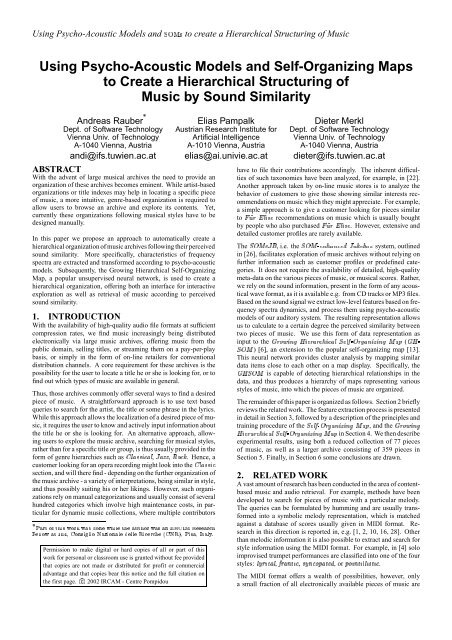


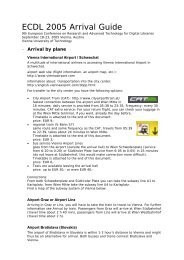
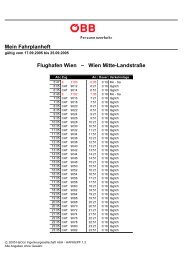
![Informationsvisualisierung [WS0708 | 01 ]](https://img.yumpu.com/22537403/1/190x143/informationsvisualisierung-ws0708-01-.jpg?quality=85)
